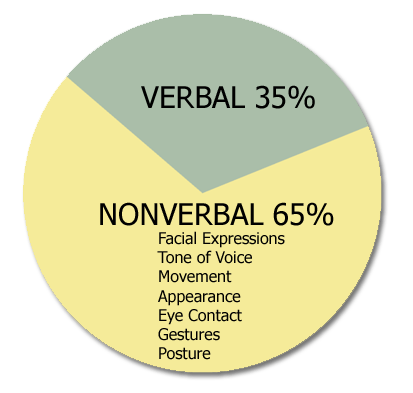Non-verbal
Nonverbal communication is prevalent in any kind of face-to-face communication. A study done by UCLA indicates that up to 93 percent of communication effectiveness is determined by nonverbal cues. This means that we communicate more through our gestures and facial expressions than words.
This form of communication is not only important when we are talking to one another informally, it is also important when we give a formal presentation. The effectiveness of a presentation is determined by how well the presenter connects to the audience.
There are numerous ways to connect to the audience. You can ask questions and involve the audience or you can just use nonverbal communication. The audience feels more involved if you make eye contact with them and make them feel as though you are focusing on them.
More than just a connection, you can entertain your audience and maintain their interest by using gestures and facial expressions. Many people are visual learners, and these gestures and facial expressions may be the key to gaining their attention and interest.

Oral Presentation for the Photo Essay
As an in class activity, pairs were given a scenario to act out without using words. We were permitted to use gestures, eye contact, posture, and other forms of movement, but we were not allowed to make sounds.
My group of three was given the scenario that a wife was cheating on her husband. In order to act this out, my partners and I used very extensive gestures. We used our arms and hands to make things look bigger if we were trying to convey anger. On the other hand, we hunched over and wiped away a tear if we were trying to convey sadness.
All of these expressions are used in acting on a daily basis to support what the actors are saying. We did exactly what actors do minus the dialogue.
Network Prezi Presentation and JumpStart Project Presentation
Both the Network Prezi Presentation and the JumpStart Project Presentation were formal oral presentations. As a result of this, my group and I had to practice our nonverbal communicating skills. We practiced looking out into the audience and making eye contact with each member of the audience.
Moreover, we also practiced gestures that enhanced the effect of what we were saying and what was on the screen for the presentation. An example of this is that if I was trying to say that there was a large difference, I would spread my hands apart and show the audience how large the difference actually was.
Overall, nonverbal communication made both of these presentations much more effective.




ALIZEH'S PORTFOLIO